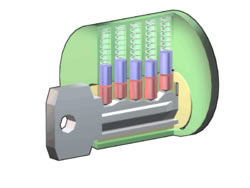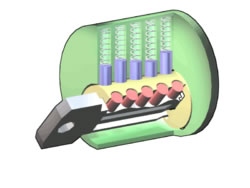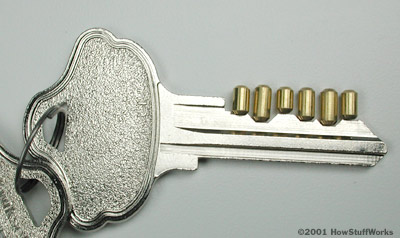So how does a traditional key work? We are all familiar with the various teeth and unique shape of each key, but what exactly does a key do when placed in a lock; the answer varies for each type of key. Since the house key is the most commonly used type of key in modern times, I chose to explore its basic workings via information from The Open Locksport Guide:
The basic principles of the pin tumbler lock may date as far back as 2000 BC in Egypt; the lock consisted of a wooden post affixed to the door, and a horizontal bolt that slid into the post. The bolt had vertical openings into which fitted a set of pins. These could be lifted, using a key, to a sufficient height to allow the bolt to move and unlock the door.
Inventor Linus Yale, Sr. patented a cylindrical pin tumbler lock in 1848, a design which was further improved and patented by his son, Linus Yale, Jr., in 1861. Yale, Jr.'s design is very similar to pin tumbler locks manufactured today.
The pin tumbler is commonly used in cylinder locks. In this type of lock, an outer casing has a cylindrical hole in which the plug is housed. To open the lock, the plug must rotate.
The plug has a straight-shaped slot known as the keyway at one end to allow the key to enter the plug; the other end may have a cam or lever which activates a mechanism to retract a locking bolt. The keyway often has protruding ledges which serve to prevent the key pins from falling into the plug, and to make the lock more resistant to picking. A series of holes, typically five or six of them, are drilled vertically into the plug. These holes contain key pins of various lengths, which are rounded to permit the key to slide over them easily.
Above each key pin is a corresponding set of driver pins, which are spring-loaded. Simpler locks typically have only one driver pin for each key pin, but locks requiring multi-keyed entry, such as a group of locks having a master key, may have extra driver pins known as spacer pins. The outer casing has several vertical shafts, which hold the spring-loaded pins.
When the plug and outer casing are assembled, the pins are pushed down into the plug by the springs. The point where the plug and cylinder meet is called the shear point. With a key properly cut and inserted into the groove on the end of the plug, the pins will rise causing them to align exactly at the shear point. This allows the plug to rotate, thus opening the lock. When the key is not in the lock, the pins straddle the shear point, preventing the plug from rotating. Sets of locks with a master key will have one set of shear points that are identical to the others in the set and one set that is unique to that specific lock.
Step 1: The pins are leveled with the notches in the key

Step 2: The plug can now rotate

A closer look at the mechanism

Back to The Key main page
